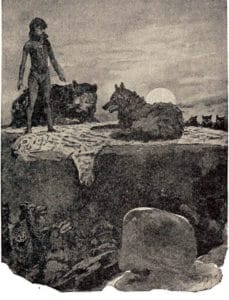By Roel Hoekstra (‘76), Treasurer, Holt Elwell Memorial Foundation
“And he grew and grew strong as a boy must grow who does not know that he is learning any lessons, and who has nothing in the world to think of except things to eat.”
What does it take in today’s ever faster, ever more connected world to develop young men of strength and character? Men willing and eager to change the world for the better; to raise strong families; to sacrifice, sweat and struggle building communities that thrive while respecting and protecting the natural world we live in.
In the age of Facebook, Xbox, year-round athletic programs, SATs, and 30-year-old college graduates living with their parents, is it reasonable to look back to a children’s book written in 1884 for the answers to how we guide young boys through the minefield of middle school and send them to high school as strong, independent, confident young men ready to grab life by the horns? Well … yes, it is.
Kipling’s Time – The Industrial Revolution
When Rudyard Kipling wrote The Jungle Book, the Industrial Revolution was in full swing. Families were moving from an agricultural lifestyle into cities to work in factories and industry.
It is hard for us to imagine, but at the time there was a general concern that our men were becoming too soft, removed and unappreciative of the splendor of the natural world. The Jungle Book went on to become the best-selling children’s book of all time, and Mowgli went on to fame and fortune on the silver screen.
Why? Because the book is a parable. Mowgli is you and me. A young and helpless boy alone in a big, bad world. He shows up naked and vulnerable but not afraid, as he doesn’t know any better. To survive he needs the support of parents, friends, teachers … indeed, an entire community that has his back. A wolf pack!
 Kipling set the story in the “Jungle.” In the natural world where the laws are firm and harsh but fair for all. He seemed to be implying that the natural way was superior to the brutal and capricious ways of man. After young Mowgli is accepted into the wolf pack, he spends several years learning how to survive in the natural world. Kipling does not elaborate on this, but rather summarizes these years as follows:
Kipling set the story in the “Jungle.” In the natural world where the laws are firm and harsh but fair for all. He seemed to be implying that the natural way was superior to the brutal and capricious ways of man. After young Mowgli is accepted into the wolf pack, he spends several years learning how to survive in the natural world. Kipling does not elaborate on this, but rather summarizes these years as follows:
“Take him away,” Akela said to Father Wolf, “and train him as befits one of the Free People.”
And that is how Mowgli was entered into the Seeonee Wolf Pack for the price of a bull and on Baloo’s good word.
Now you must be content to skip ten or eleven whole years, and only guess at all the wonderful life that Mowgli led among the wolves, because if it were written out it would fill ever so many books. He grew up with the cubs, though they, of course, were grown wolves almost before he was a child. And Father Wolf taught him his business, and the meaning of things in the jungle, till every rustle in the grass, every breath of the warm night air, every note of the owls above his head, every scratch of a bat’s claws as it roosted for a while in a tree, and every splash of every little fish jumping in a pool meant just as much to him as the work of his office means to a business man. When he was not learning he sat out in the sun and slept, and ate and went to sleep again. When he felt dirty or hot he swam in the forest pools; and when he wanted honey (Baloo told him that honey and nuts were just as pleasant to eat as raw meat) he climbed up for it, and that Bagheera showed him how to do. Bagheera would lie out on a branch and call, ‘Come along, Little Brother,’ and at first Mowgli would cling like the sloth, but afterward he would fling himself through the branches almost as boldly as the gray ape.”
Our founder, Mrs. Holt, was not content to just skip 10 or 11 years. She wisely realized that the story and the process contained in that brief paragraph could be used to create an experiential learning program that would take young boys from helpless and silly children to strong men of character.
Mrs. Holt’s Vision
And so she wrote to Rudyard Kipling, who was living in Vermont at the time, to ask if she could use the characters in the book as the model for a summer camp, or a “School Of The Open,” as she called it. He enthusiastically wrote back that it would be fine and to do so with his blessing. He also answered two pressing questions she had. Since she was to have many boys at Camp, how would she use the plural form of Mowgli and importantly … how do you actually pronounce Mowgli? He responded that you would add an “s” to the end, but that it would be silent. And that Mowgli is pronounced “Mow” as in “cow.” So it is with irritation that I have to listen to Disney mispronounce the name Mowgli over and over again!
So what started with 11 campers in 1903 has grown to serve thousands of boys over 113 years, but what is most remarkable is that the program, the process, the “School Of The Open” that she developed (and Colonel Elwell refined) has changed so little over the years. Or that the mission of the program has never been as relevant as it is today.
 Camp Mowglis Today
Camp Mowglis Today
Enter as a Cub. Just as Mowgli joined the Seeonee Wolf Pack as a man-cub with the other wolf cubs, our youngest campers ages 8 and 9 join Mowglis and learn critical life lessons (Law of the Jungle) without effort. While it might seem to be all play … indeed, the Cubs are learning how to function independently from their parents, how to be a part of a group of peers, how to face challenges and overcome fears, all while under the close guidance of a Cub Mother and a group of strong young men.
The Cubs operate as their own group under the watchful eye of a Cub Mother and the supervision and guidance of a select group of Sr. Staff (generally college men of outstanding character). So think about that for just a minute. How many 9-year-old boys get to explore the lakes, mountains, trails, and streams of N.H. with 15 of their closest friends under the tutelage and guidance of four or five caring big brothers? This experience sets the foundation for handling the responsibility, opportunity, and increased independence that life in the Pack will bring.
Move to the Pack
Acceptance into the Pack. Once a boy is admitted to the Pack, he is part of a society with structure, rules, consequences, and support that exists to create men of character. A year or two as a Cub has prepared him to learn and thrive in this rough-and-tumble environment. While there is one Pack, I like to think of it in two parts representing the growth of Mowgli from boy to man.
The Lower Camp (Toomai, Baloo, and Akela), where boys 10, 11, and 12 learn the basic skills required for survival in the “Jungle”: being true to yourself as an individual, while living and supporting the group as a whole, learning to swim, sail, canoe, hike, camp, shoot a rifle and a bow and arrow. All these skills are learned at a basic level under the strict guidance of seasoned and knowledgeable teachers. So just as Mowgli has Baloo and Bagheera as teachers, so our young Mowglis Men are taught by older brothers (Sr. Staff) who are committed to their success.
The Upper Camp (Panther and The Den) for boys 13 and 14. During these final two summers, boys are challenged and tested. The hikes become multi-day pack trips. The Crew teams race hard for glory. Success in an industry requires a real mastery of the activity. In recognition of their status as leaders of the Camp, these older boys are asked and expected to look out for and support the growth of the younger campers.
And just as Kipling suggested, our Mowglis Men learn all these lessons while having fun. And today that fun is real, unconnected, and authentic fun. No TV fun. No Xbox fun. Swimming, sailing, tetherball, soccer, camping, exploring, reading fun. Exhausted at 9 pm and ready to go to sleep. Fun, nervous anticipatory fun. Rain-soaked and summiting Mt. Washington fun. So hoarse from cheering on the Racing Crews I can’t talk fun. Can’t wait to tell my parents what I can do now fun.
For the worthy … graduation. Perhaps Mowglis is unique in this manner … I don’t know, but as Rudyard Kipling imagined in 1885 and as Mrs. Holt brought to life in the early 1900s, once the lessons of the “Jungle” are learned, young Mowgli leaves the support of the Pack and heads out into the world to make a name for himself. For us, that means graduating.
For me, it meant leaving Camp Mowglis as a self-confident, mature 14-year-old young man and heading off to face high school knowing I could handle any adversity thrown my way. I saw the same knowing look in my grandfather’s eye as he listened to my stories. I saw the same lively step when my two sons left Camp and started their high school careers.
Camp Mowglis of Tomorrow
The world changes quickly and seems to get smaller as information is shared globally in real time. Camp Mowglis, our program, and traditions live on and are as strong and relevant today as 100 years ago. Our Camp has had strong leaders who brought the story of The Jungle Book to life. As Akela was the wise old wolf, the leader of the wolf pack, who looked after the best interests of each wolf individually and the pack as a whole, today our Director, Mr. Robbins, takes his place on Council Rock each evening and sees 100-plus young Mowgli to nurture and guide and a Mowglis pack thousands strong reaching back generations to protect.
Mowglis 2016, I salute you!



















































































































































































